Exercise
2. An electicle is projected horizontally with a kinetic energy of 10 keyV. Amagnetic field of strength 1.0 × 10-7
T exists in the vertically upward direction.
(a) Will the electron deflect towarde towards left of its motion?

Ans. 3.0
6. When a proton is released from rest in a room, it starts with an initial acceleration a0 towards we
When it is projected towards north with a speed v0, it moves with an initial acceleration 3a0 towards west.
Find the electric field and the maximum possible magnetic field in the room.

7. Consider a 10 cm long portion of a straight wire carrying a current of 10 A placed in a magnetic field of 0.1
T making an angle of 53º with the wire. What magnetic force does the wire experience?
Ans. 0.08 N perpendicular to both the wire and the field
8. A current of 2 A enters at the corner d of a square frame abcd of side 20 cm and leaves at the opposite corner b.
A magnetic field B = 0.1 T exists in the space in direction perpendicular to the plane of the frame as shown in figure.
Find the magnitude and direction of the magnetic forces on the four sides of the frame.

Ans. 0.02 N on each wire, on da and cb towards left and on dc and ab downward.
9. A magnetic field of strength 1.0 T is produced by a strong electromagnet in a cylindrical
region of radius 4.0 cm as shown in figure. A wire, carrying a current of 2.0 A, is placed
perpendicular to and intersecting the axis of the cylindrical region.
Find the magnitude of the force acting on the wire.

Ans. 0.16 N

11. A current of 5.0 A axis in the circuit shown in figure (34 – E3). The wire PQ has a lengths of 50 cm
and the magnetic field in which it is immersed has a magnitude of 0.20 T. Find the magnetic force acting on the wire PQ.

Ans. 0.50 N towards the inside of the circuit
12. A circular loop of radius a, carrying a current i, is placed in a two-dimensional magnetic field.
The centre of the loop cooincides with the centre of the field (figure). The strength of the magnetic
field at the periphery of the loop is B. Find the magnetic force on the wire.
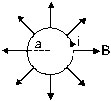
Ans. 2paiB, perpendicular to the plane of the figure going into it.

field B exists in the z-direction. Find the magnitude of the magnetic force on the portion
of the wire between x = 0 and x = lambda
Ans. i lambda B
19. A rigid wire consists of a semicircular portion of radius R and two straight sections (figure).
The wire is partially immersed in a perpendicular magnetic field B as shown in the figure.
Find the magnetic force on the wire if it carries a current i.
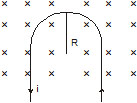
Ans. 2iRB, upward in the figure
21. Figure shows a rod PQ of length 20.0 cm and mass 200 g suspended through a fixed point
O by two threads of lengths 20.0 cm each. A magnetic field of strength 0.500 T exists in the vicinity
of the wire PQ as shown in the figure. The wires connecting PQ will the battery are loose and
exert no force on PQ. (a) Find the tension in the threads when the switch S is open.
(b) A current of 2.0 A is established when the switch S is closed. Find the tension in the threads now.
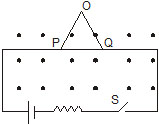
Ans. (a) 1.13 N (b) 1.25 N
22. Two metal strips, each of length l, are clamped parallel to each other on a horizontal floor
with a separation b between them. A wire of mass m lies on them perependicularly as shown in figure.
A vertically upward the wire and the floor is m. A current i is established when the switch S is closed at the
instant t = 0. Discuss the motion of the wire after the switch is closed. How far away from the strips will the wire reach?

23. A metal wire PQ of mass 10 g lies at rest on two horizontal metal rails separated by 4.90 cm (figure).
A vertically downward magnetic field of magnitude 0.800 T exists in the space. The resistance of the circuit is
slowly decreased and it is found that when the resistance goes below 20.0 ohm the wire PQ
starts sliding on the rails. Find the coefficient of friction.

Ans. 0.12
24. A straight wire of length l can slide on tow parallel plastic rails kept in a horizontal plane with a separation d.
The coefficient of friction between the wire and the rails is m. If the wire carries a current i,
what minimum magnetic field should exist in the space in order to slide the wire on the rails.

25. Figure shows a circular wire-loop of radius a, carrying a current i, placed in a perependicular magnetic field B.
(a) Consider a small part dl of the wire. Find the force on this part of wire exerted by the magnetic field.
(b) Find the force of compression in the wire.
Ans. (a) idlB towards the centre (b) iaB
26. Suppose that the radius of cross-section of the wire used in the previous problem is r. Find the increase
in the radius of the loop if the magnetic field is switched off. The Young’s modulus of the material of the wire is Y.
Ans. ia2B /pier 2Y .
27. The magnetic field existing in a region is given by
A square loop of edge l
Sol. The magnitude of magnetic field varies along x-axis.
It can be observed that force on wire PQ and RS have same magnitude but opposite directions.
![]()
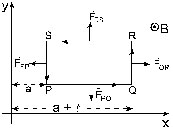
\
28. A conducting wire of length l, lying normal to a magnetic field B, moves with a velocity v as shown in figure.
(a) Find the average magnetic force on a free electron of the wire
. (b) Due to this magnetic forceelectrons concentrate at one end resulting in an electric field inside the wire.
The redistribution stops when the electric force on the free electrons balances the magnetic force.
Find the electric field developed inside the wire when the redistribution stops.
(c) What potential difference is developed between the ends of the wire?

Ans. (a) evB (b) vB (c) iBv
29. A current i is passed through a silver strip of width d and area of cross-section A. The number of free electrons per unit volume is n.
(a) Find the drift velocity v of the electrons. (b) If a magnetic field B exists in the region as shown in figure,
what is the average magnetic force on the free electrons? (c) Due to the magnetic force, the free electrons get accumulated on
one side of the conductor along its length. This produces a transverse electric field in the conductor
which opposes the magnetic force on the electrons. Find the magnitude of the electric field which will stop further
accumulation of electrons. (d) What will be the potential difference developed across the width of the conductor
due to the electron accumulation? The appearance of a transverse emf, when a current-carrying wire is placed
in a magnetic field, is called Hall effect.


30. A particle having a charge of 2.0 × 10–8 C and a mass of 2.0 × 10–10 g is projected with a speed of 2.0 × 103 m/s
in a region having a uniform magnetic field of 0.10 T. The velocity is pependicular to the field.
Find the radius of the circle formed by the particle and also the time period.
Ans. 20 cm, 6.3 × 10–4 s
31. A proton describes a circle of radius 1 cm in a magnetic field of strength 0.10 T.
What would be the radius of the circle described by an a-particle moving with the same speed in the same magnetic field?
Ans. 2 cm
32. An electron having a kinetic energy of 100 eV circulates in a path of radius 10 cm in a magnetic field.
Find the magnetic field and the number of revolutions per second made by the electron.
Ans. 3.4 × 10–4 T, 9.4 × 10–6
33. Protons having kinetic energy K emerge from an acceleration as a narrow beam.
The beam is bent by a perependicular magnetic field so that it just misses a plane
target kept at a distance l in front of the accelerator. Find the magnetic field.

34. A charged particle is accelerated through a potential difference of 12 kV and acquire
s a speed of 1.0 × 10–6 m/s. It is then injected perpendicularly into a magnetic field
of strength 0.2 T. Find the radius of the circle described by it.
Ans. 12 cm
36. A proton is projected with a velocity of 3 × 106 m/s perpendicular to a uniform magnetic
field of 0.6T. Find the acceleration of the proton.
Ans. (a) 3.2 × 10–15 N (b) 2.1 × 10–4 m (c) 1.31 × 10–7 s
37. (a) An electron moves along a circle of radius 1 m in a perpendicular magnetic field of strength
0.50 T. What would be its speed? Is it reasonable? (b) If a proton moves along a circle of the same
radius in the same magnetic field, what would be its speed?
Ans. (a) 8.8 × 10 10 m/s (b) 4.8 × 10 7 s
38 . A particle of mass m and positive charge q, moving with a uniform velocity v,
enters a magnetic field B as shown in figure.
(a) Find the radius of the circular are it describes in the magnetic field.
(b) Find the angle subtended by the are at the centre.
(c) How long does the particle stay inside the magnetic field?
(d) Solve the three parts of the above problem if the charge q on the particle is negative.
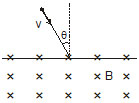

40. A narrow beam of singly-charged carbon ions, moving at a constant velocity of 6.0 × 104 m/s,
is sent perpendicularly in a rectangular region having uniform magnetic field B = 0.5 T (figure).
It is found that two beams emerge from the field in the backward direction, the separations from the
incident beam being 3.0 cm and 3.5 cm. Identify the isotopes present in the ion beam.
Take the mass of an ion = A(1.6 × 10–27) kg, where A is the mass number.

Ans. 12C and 14C
41. Fe+ ions are accelerated through a potential difference of 500 V and are injected normally
into a homogeneous magnetic field B of strength 20.0 mT. Find the radius of the circular paths
followed by the isotopes with mass numbers 57 and 58. Take the mass of an ion = A(1.6 × 10–27) kg,
where A is the mass number.
Ans. 119 cm and 120 cm
43. Figure shows a convex lens of focal length 12 cm lying in a uniform magnetic field B of magnitude
1.2 T parallel to its principal axis. A particle having a charge 2.0 × 10–3 C and mass 2.0 × 10–6 kg is
projected perpendicular to the plane of the diagram with a speed of 4.8 m/s. The particle moves along a circle
with its centre on the principal axis at a distance of 18 cm from the lens. Show that the image of the particle
goes along a circle and find the radius of that circle.

Ans. 8 cm
44. Electrons emitted with negligible speed from an electron gun are acceleration through a potential difference
V along the x-axis. These electrons emerges from a narrow hole into a uniform magnetic field B directed along this axis.
However, some of the electrons emerging from the hole make slightly divergent angles as shown in figure.
Show that these paraxial electrons are refocused on the X-axis at a distance


Ans.
45.Two particles, each having a mass m are placed at a separation d in a uniform magnetic field B as shown in figure.
They have opposite charges of equal magnitude q. At time t = 0, the particles are projected towards each other,
each with a speed v. Suppose the Coulomb force between the charges is switched off.
(a) Find the maximum value vm of the projection speed so that the two particles do not collide.
(b) What would be the minimum and maximum separation between the particles if v = vm/2?
(c) At what instant will a collision occur between the particle if v = 2vm?
(d) Suppose v = 2vm and the collision between the particles is completely inelastic.
Describe the motion after the collision.

![]()
(d) the particles stick together and the combined mass moves with constant speed vm along
the straight line drawn upward in the plane of figure through the point of collision.
46. A uniform magnetic field of magnitude 0.20 T exists in space from east to west.
With what speed should a particle of mass 0.010 g and having a charge 1.0 × 10–5
C be projected from south to north so that it moves with a uniform velocity?
Ans. 49 m/s
47. A particle moves in a circle of diameter 1.0 cm under the action of a magnetic field of 0.40 T.
An electric field of 200 V/m makes the path straight. Find the charge/mass ratio of the particle.
Ans. 2.5 × 10 5 C/kg
48. A proton goes underflected in a crossed electric and magnetic field (the field are perependicular to each other)
at a speed of 2.0 × 106 m/s. The velocity is perependicular to both the fields. When the electric field is switched off,
the proton moves along a circle of radius 4.0 cm. Find the magnitude of the electric and the magnetic fields.
Take the mass of the proton = 1.6 × 10–27 kg.
Ans. 1.0 × 104 m/s, 1.0 × 105
49. A particle having a charge of 5.0 mC and a mass of 5.0 × 10–12 kg is projected with a speed of 1.0km/s
1.0 km/s in a magnetic field of magnitude 5.0 mT. The angle between the magnetic field and the velocity is sin–1 (0.90)
. Show that the path of the particle will be a helix. Find the diameter of the helix and its pitch.
Ans. 36 cm, 56 cm
50. A proton projected in a magnetic field of 0.020 T travels along a helical path of radius 5.0 cm and pitch 20 cm.
Find the components of the velocity of the proton along and perpendicular to the magnetic field.
Take the mass of the proton = 1.6 × 10–27 kg.
Ans. 6.4 × 10 4 m/s, 1.0 × 10 5
51. A particle having mass m and charge q is released from the origin in a region in which electric
field and magnetic field are given by
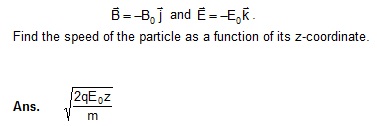
53. A rectangular coil of 100 turns has length 5 cm and width 4 cm. It is placed with its plane parallel to a
uniform magnetic field and a current of 2A is sent through the coil. Find the magnitude of the magnetic field B,
if the torque acting on the coil is 0.2 N-m.
Ans. 0.5 T
54. A 50-turn circular coil of radius 2.0 cm carrying a current of 5.0 A is rotated in a magnetic field of strength 0.20 T.
(a) What is the maximum torque that acts on the coil? (b) IN a particular position of the coil, the torque acting on it is half of this maximum.
What is the angle between the magnetic field and the plane of the coil?
Ans. (a) 6.3 × 10–2 N-m (b) 90º
55. A rectangular loop of sides 20 cm and 10 cm carries a current of 5.0 A. A uniform magnetic
field of magnitude 0.20 T exists parallel to the longer side of the loop.
(a) What is the force acting on the loop?
(b) What is the torque acting on the loop?
Ans. (a) zero (b) 0.02 N-m parallel to the shorter side.
56. A circular coil of radius 2.0 cm has 500 turns in it and carries a current of 1.0 A.
Its axis makes an angle of 30º with the uniform magnetic field to magnitude
0.40 T that exists in the space. Find the torque acting on the coil.
Ans. 0.13 N-m
57. A circular loop carrying a current i has wire of total length L. A uniform magnetic field B
exists parallel to the plane of the loop. (a) Find the torque on the loop.
(b) If the same length of the wire is used to form a square loop, what would be the torque? Which is larger?
Ans. (a) iLB/4pie (b) iL2B/16
58. A square coil of edge l having n turns carries a current i. It is kept on a smooth horizontal plate.
A uniform magnetic field B exists in a direction parallel to an edge. The total mass of the coil is M.
What should be the minimum value of B for which the coil will starts tipping over?
Ans. Mg/2nil

